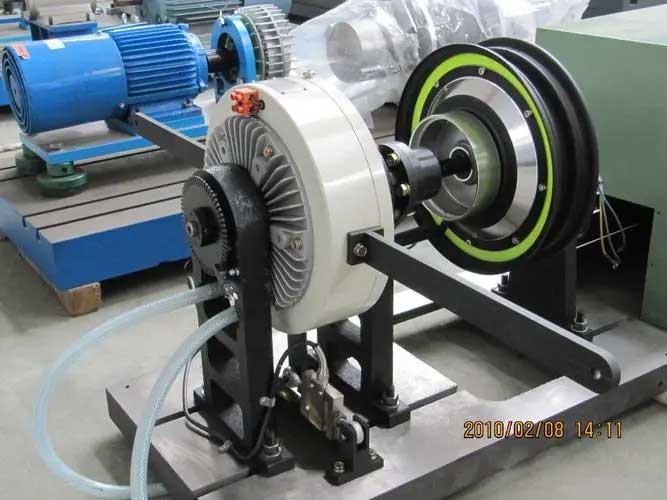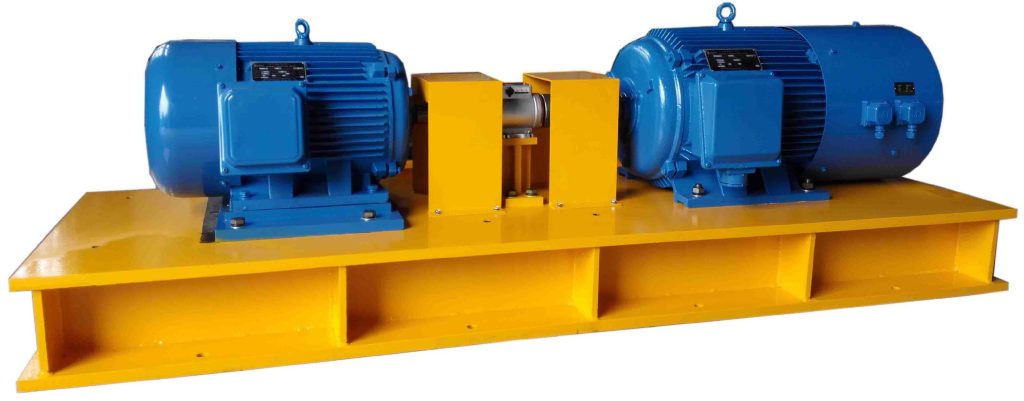What is electric motor dynamometer

An electric motor dynamometer is a device that measures mechanical torque. The essence is a DC generator in which the stator can also rotate. When the torque is input on the rotating shaft, its movable stator deflects due to the counter torque, and the torque can be measured conveniently and accurately by using the scale and the lever arm mounted on the stator. If the rotational speed is measured at the same time, the mechanical power can be calculated. The electric motor dynamometer is not only suitable for testing the performance of the motor in the laboratory, but also for the production line to test the factory of the motor products.
The electric motor dynamometer is divided into high speed, medium speed, and low speed. According to the different speed of the motor, different dynamometers are selected to test the torque, speed, and power of the motor.

Two configurations of the electric motor dynamometer
- Simple configuration: electrical parameter measuring instrument (single-phase, three-phase, DC), electric motor dynamometer controller, electric motor dynamometer, motor fixture.
- Complete configuration: electric motor dynamometer, electric motor dynamometer controller, electrical parameter measuring instrument (single-phase, three-phase, DC), AC variable frequency power supply/DC power supply, fixture, industrial computer display, control console, test software, motor fixture, Couplings, water cooling systems, etc.
Three types of electric motor dynamometer
Types 1#: Hysteresis electric motor dynamometer
The hysteresis dynamometer is composed of a toothed pole stator, a hollow hysteresis cup rotor, an excitation line diagram, a bracket, a bottom plate, etc. When the internal coil of the hysteresis dynamometer passes current, the magnetic field lines are generated and a magnetic circuit is formed. Torque, changing the excitation current can change the load torque.
Application: It is suitable for testing motors with small and medium torque and high speed, such as asynchronous motors, low-power DC motors, series motors, and electric tool industries.
Types 2#: Magnetic particle electric motor dynamometer
The magnetic particle electric motor dynamometer is composed of a stator, a solid rotor, an excitation coil, a magnetic particle medium, a bracket, a bottom plate, etc. When the internal coil of the magnetic particle electric motor dynamometer passes through a current, a magnetic field is generated, so that the internal magnetic particle is arranged into a magnetic chain according to the magnetic force line, and the pulling force generated by the magnetic particle chain becomes the resistance to prevent the rotor from rotating, and this force is the load moment. Changing the excitation current can change the load torque.
Application: Suitable for occasions with high torque and low speed. Such as starter electric motor constant torque on-load start, asynchronous motor, DC geared electric motor and constant tension control used in papermaking, textile, and other industries.
Types 3#: Eddy current electric motor dynamometer
The eddy current electric motor dynamometer is composed of an inductor (rotor), an armature and an excitation winding, a torque sensor, a speed sensor, a base plate, etc. When the inductor is driven to rotate by the motor, the air gap magnetic flux density will increase with the rotation of the inductor. There are periodic changes. Therefore, the eddy current electric motor electromotive force is induced on the surface of the eddy current ring and within a certain depth, and an eddy current is generated. The magnetic field generated by the eddy current interacts with the air gap magnetic field to generate braking torque. Changing the excitation current of the stator can adjust the torque of the power machine under test.
Application: It is suitable for torque and power measurement of high-speed, high-power power machinery, especially for simulation life tests and temperature rise tests of power machinery, such as series motors, electric tools, and high-power motors.Application of electric motor dynamometer
Electric motor dynamometers are used in the following motors: single-phase asynchronous motors (washing machine motors, range hood motors, fan motors, air conditioner motors, compressor motors), shaded pole motors, DC motors, series pole motors, power tools, three-phase motors, Synchronous motors, speed regulating motors, stepper motors, wiper motors, window motors, automobile heater motors, motorcycle starter motors, etc.
Function of electric motor dynamometer
Main performance
- The test data are digitally displayed and can be sent to the computer for sampling, curve drawing and printing;
- Adopt high-precision load sensor; good stability and long service life;
- The whole machine has high sensitivity, good load torque stability and test repeatability;
- The size of the load can be controlled only by adjusting the excitation current
- The software operation is easy to learn, and can realize manual, automatic, fixed-point and other test methods.
- The power tester has multiple ranges (automatic switching) to meet the test of high-power motors and small-power motors
- The three-dimensional adjustment platform can facilitate the installation of the motor and realize fast clamping.
System functions
- Can control the switch operation of the motor on the computer;
- The system has manual and automatic test methods (this method can be operated without connecting to the computer). The whole process can be realized on the display controller on the control cabinet; the data can be locked for manual recording;
- The system has an automatic test method: that is, the load is automatically loaded according to the setting, and the characteristic curve of the motor from no-load to stalled (or set value) is scanned;
- The system has a fixed-point test method: that is, after the motor is running, the load is automatically adjusted to the set value and runs stably at the set value;
- Test results: The motor test data is displayed in the form of a report or a curve, which can be printed and saved, so that it is convenient to open the query curve next time, and the curve coordinate parameters (abscissa and ordinate) can be modified
- Rated torque test accuracy: ±0.5%; speed accuracy ±0.2%;
- Dynamometer range: 0.01Nm-300Nm (customers can choose a dynamometer with a suitable range according to their own motor power)
Software introduction
Test items
- Set safe values for current, torque, speed, and output power during no-load, load, and locked-rotor tests, and can automatically push out the limits.
- Automatic loading and manual loading test:
- A Load test loading speed is adjustable: self-adjust according to actual needs.
- B test loading increment is adjustable: the initial loading amount and increment can be set.
- Fixed-point test: It can test the current, torque, speed and power. You can set one point not to uninstall; set multiple points to uninstall. The number of fixed points can be set up to 5 points. Fixed-point data can be set.
- Endurance test: test steps 1 2 3 4 5; operation mode: no-load, torque, input power, output power, accident can be set freely; durability value and error value under each item can be set freely; The test time can also be set arbitrarily.
Nameplate parameters
- Motor model, rated power, rated voltage, rated speed, customer name, customer file, tester, test date.
- Parameters are used as reports to help customers organize and analyze data.
Curve coordinates
Two modes, seven coordinate curves.
Two modes: speed mode and torque mode. The two modes are just ways of analyzing the data.
Seven curves: voltage, current, speed, torque, input power, output power, efficiency. The maximum value of each curve and the curve represented by the color can be set arbitrarily, which is convenient for data analysis.
Storage and Recall of Motor Parameters
The parameters of each motor can be stored after setting, so that the next use and call do not need to be re-set.
Test interface
The test interface can display the instantaneous value of the test (voltage, current, speed, torque, input power, output power, efficiency) in real time, and can collect data according to a certain time (arbitrary setting). At the same time, the curve is automatically drawn during the test. Better monitoring of the testing process.
Report analysis
- The graph of the whole test process (voltage, current, speed, torque, input power, output power, efficiency)
- Nameplate parameter value
- Analysis of motor performance at key points
- No-load point: current value and speed value
- Maximum torque point: torque value, speed value, current value, output power value, efficiency value
- Maximum output power point: torque value, speed value, current value, output power value, efficiency value
- The highest efficiency value: torque value, speed value, current value, output power value, efficiency value
Read More: Dynamometer Wikipedia